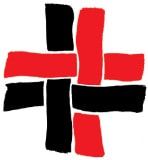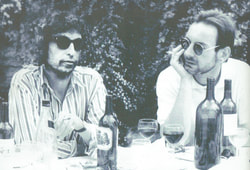The parallel between what Rauschenberg did in 1953 and what Dylan is doing now has haunted me since I read Doug MacCash's piece in The Times-Picayune yesterday, in which he argued, based on a recent show, that Bob was also, maybe, erasing some of his previous work.
Let's start with what's different and get that out of the way.
Rauschenberg erased a work by De Kooning. The suggestion here is that Dylan is erasing works by Dylan. This is not (necessarily) self-referring: Dylan recognises that, once the work is in the public domain, it is owned by anyone and everyone. And it is the work in the public domain - on disc or in memory - that is being erased on this tour. And that's the second difference: we have no record of the De Kooning drawing which Rauschenberg erased. But we have both a physical and a cerebral, intellectual record of, for example, All Along the Watchtower, the song that prompted MacCash's insight when it was performed in New Orleans earlier this week.
This is significant, because it makes the process of erasure a public act rather than, as De Kooning believed when he donated his drawing, a private matter between two artists. De Kooning was alleged to be angry when the erased drawing was exhibited, and I'm guessing this was because it was intended that the act of erasure itself, the performance, rather than the end result, would be the work of art.
Dylan's exhaustive schedule on the Never-Ending Tour is proof of his belief in the power and importance of performance. And his oft-quoted statement that he never performs a song the same way twice now has a new context.
We are not talking about different interpretations any more. We are talking about elimination by performance of what exists.
This is not negative. To discover new meanings, perhaps we need to erase the old ones. To move forward, perhaps we need to eliminate the past. It's almost Oedipal. It's certainly complex. And it's complicated by the fact that, whereas Rauschenberg was destroying De Kooning, Dylan is destroying Dylan.
I suppose it is just about possible that, at any given Dylan show, there are one or two people who have never been previously exposed to Dylan; but, as we say in the niche-marketing world, they are not the audience.
Or are they?
Most of us enter into a performance with our own preconceptions, a melange of the original recording and a plethora of subsequent versions. We watch and listen for differences. From the original, from '66, from the night before.
Is Dylan now telling us, with these acts of erasure if such they be, that we should come with no preconceptions, even with no knowledge of what has gone before?
Miles Davis, of course, was able to take for granted the fact that a particular melody was a given, part of his audience's collective consciousness, and thus move immediately into his abstractions on the theme. I've argued in the past that Dylan in concert worked in a similar way, but MacCash has got me thinking. What if these songs were completely new songs, and were only available in the version which one is hearing right now? Versions in which only fragments of the old still remain as pale ghosts of what was once, but is no longer?
In other words, like a complete unknown. How would that feel?
Let me know.
Today's listening: Bob, Ryman Auditorium, Nashville. 2011-08-01. The most recent show to which I can gain access. In terms of the debate above, it's a no-decision.





 RSS Feed
RSS Feed